KIA FORTE 2020 Owners Manual
Manufacturer: KIA, Model Year: 2020, Model line: FORTE, Model: KIA FORTE 2020Pages: 568, PDF Size: 8.58 MB
Page 551 of 568
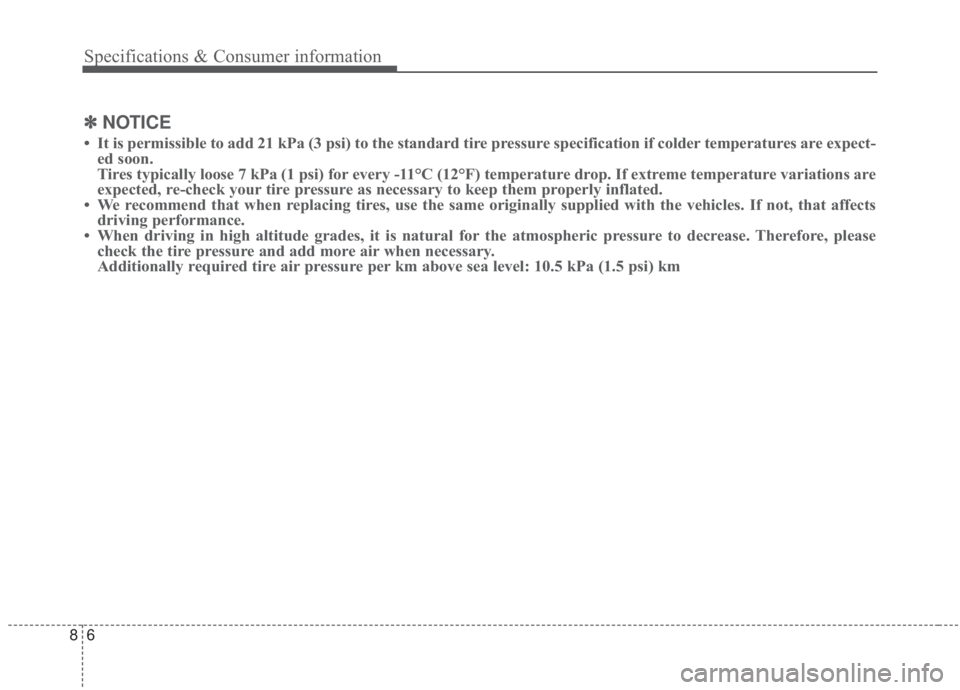
Specifications & Consumer information
68
✽ ✽NOTICE
• It is permissible to add 21 kPa (3 psi) to the standard tire pressure specification if colder temperatures are expect-
ed soon.
Tires typically loose 7 kPa (1 psi) for every -11°C (12°F) temperature drop. If extreme temperature variations are
expected, re-check your tire pressure as necessary to keep them properly inflated.
• We recommend that when replacing tires, use the same originally supplied with the vehicles. If not, that aff\
ects driving performance.
• When driving in high altitude grades, it is natural for the atmospheric pressure to decrease. Therefore, please check the tire pressure and add more air when necessary.
Additionally required tire air pressure per km above sea level: 10.5 kPa (1.5 psi) km
Page 552 of 568
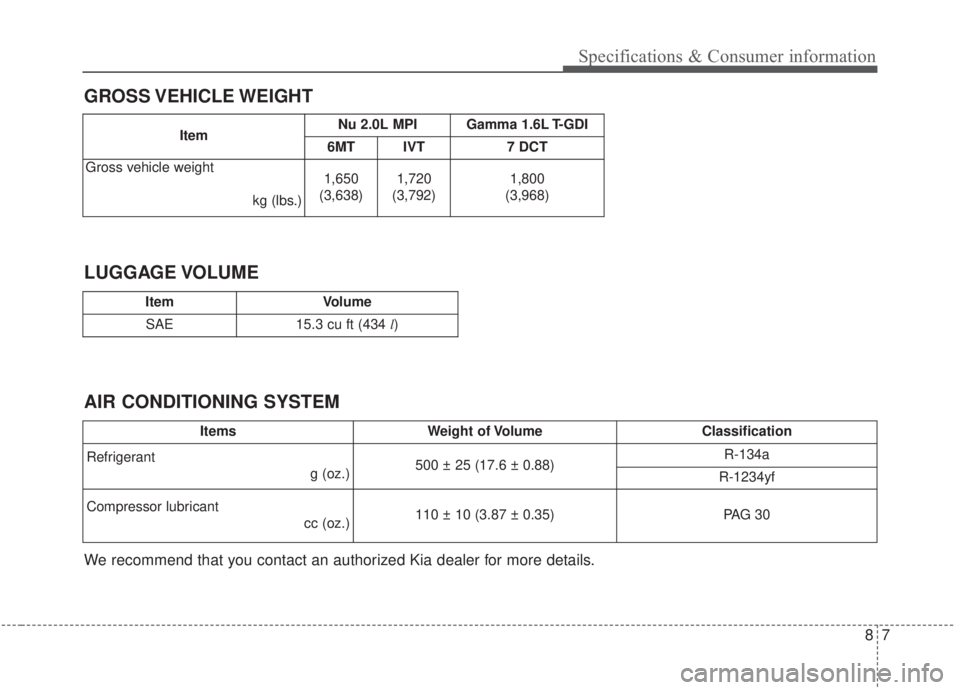
87
Specifications & Consumer information
GROSS VEHICLE WEIGHT
AIR CONDITIONING SYSTEM LUGGAGE VOLUME
We recommend that you contact an authorized Kia dealer for more details.
ItemVolume
SAE15.3 cu ft (434 l)
ItemsWeight of VolumeClassification
Refrigerant g (oz.) 500 ± 25 (17.6 ± 0.88)R-134a
R-1234yf
Compressor lubricantcc (oz.) 110 ± 10 (3.87 ± 0.35)PAG 30
ItemNu 2.0L MPI Gamma 1.6L T-GDI
6MT IVT 7 DCT
Gross vehicle weight
kg (lbs.)
1,650
(3,638)1,720
(3,792)1,800
(3,968)
Page 553 of 568
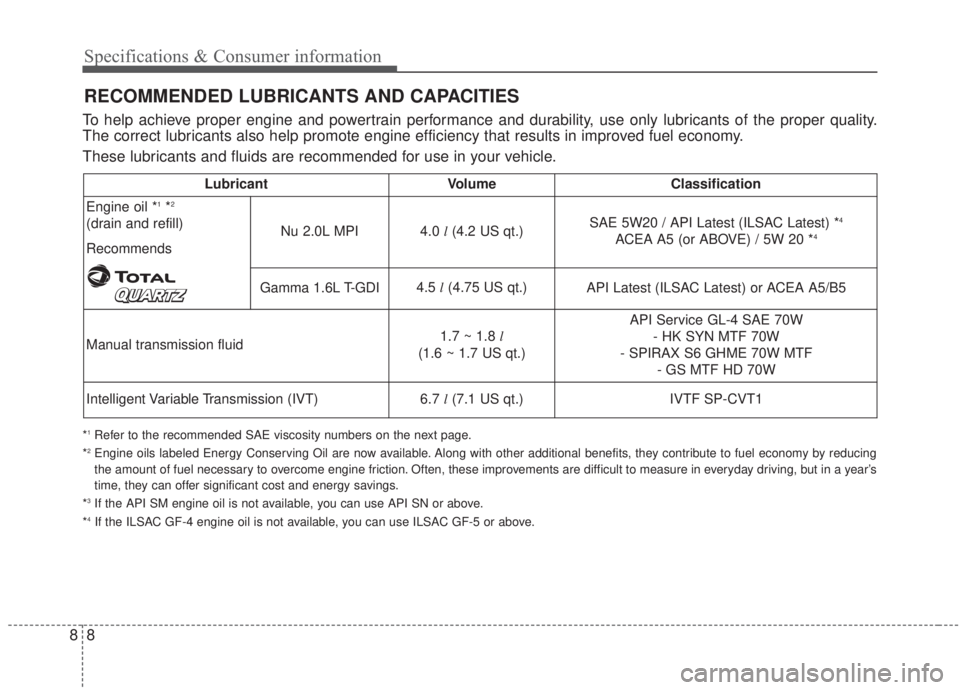
Specifications & Consumer information
88
RECOMMENDED LUBRICANTS AND CAPACITIES
To help achieve proper engine and powertrain performance and durability, use only lubricants of the proper quality.
The correct lubricants also help promote engine efficiency that results in improved fuel economy.
These lubricants and fluids are recommended for use in your vehicle.
*1Refer to the recommended SAE viscosity numbers on the next page.
*2Engine oils labeled Energy Conserving Oil are now available. Along with other additional benefits, they contribute to fuel econo my by reducing
the amount of fuel necessary to overcome engine friction. Often, these improvements are difficult to measure in everyday driving, but in a year’s
time, they can offer significant cost and energy savings.
*
3If the API SM engine oil is not available, you can use API SN or above.
*4If the ILSAC GF-4 engine oil is not available, you can use ILSAC GF-5 or above.
LubricantVolume Classification
Engine oil *
1*2
(drain and refill)
Recommends Nu 2.0L MPI4.0
l(4.2 US qt.) SAE 5W20 / API Latest (ILSAC Latest) *4
ACEA A5 (or ABOVE) / 5W 20 *4
Gamma 1.6L T-GDI4.5
l(4.75 US qt.)API Latest (ILSAC Latest) or ACEA A5/B5
Manual transmission fluid
1.7 ~ 1.8 l
(1.6 ~ 1.7 US qt.) API Service GL-4 SAE 70W
- HK SYN MTF 70W
- SPIRAX S6 GHME 70W MTF - GS MTF HD 70W
Intelligent Variable Transmission (IVT)
6.7 l(7.1 US qt.)
IVTF SP-CVT1
Page 554 of 568

89
Specifications & Consumer information
LubricantVolumeClassification
Dual clutch Transmission fluid 1.6L T-GDI
1.9~2.0 l
(1.8~1.9 US qt.) HK DCTF 70W (SK)
SPIRAX S6 GHME 70W DCTF
(H.K.SHELL)
GS DCTF HD 70W (GS CALTEX)
(API GL-4, SAE 70W)
Coolant Nu 2.0L MPIMT
5.6
l(5.9 US qt.)
Mixture of antifreeze and water
(Ethylene-glycol with phosphate based coolant for
cooling device)
IVT
6.6
l(7.0 US qt.)
Gamma 1.6L T-GDI DCT
6.9 l(7.3 US qt.)
Brake fluid
0.7 ~ 0.8 l
(0.7 ~ 0.8 US qt.) FMVSS116 DOT-3 or DOT-4
Fuel53
l(14 US gal.)Unleaded gasoline
Page 555 of 568
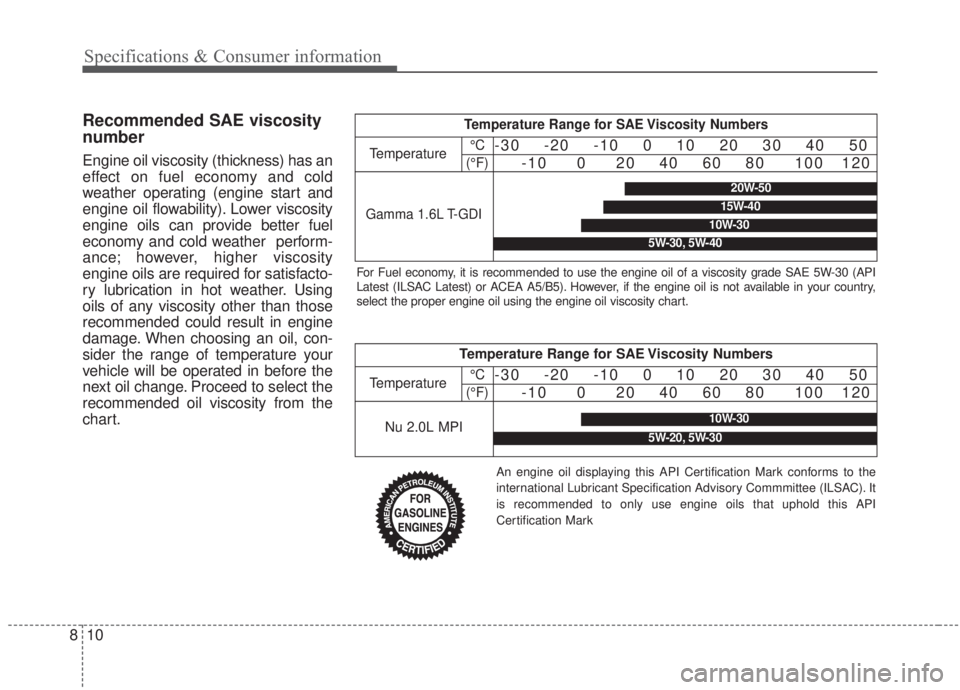
Specifications & Consumer information
10
8
Recommended SAE viscosity
number
Engine oil viscosity (thickness) has an
effect on fuel economy and cold
weather operating (engine start and
engine oil flowability). Lower viscosity
engine oils can provide better fuel
economy and cold weather perform-
ance; however, higher viscosity
engine oils are required for satisfacto-
ry lubrication in hot weather. Using
oils of any viscosity other than those
recommended could result in engine
damage. When choosing an oil, con-
sider the range of temperature your
vehicle will be operated in before the
next oil change. Proceed to select the
recommended oil viscosity from the
chart.
Temperature Range for SAE Viscosity Numbers
An engine oil displaying this API Certification Mark conforms to the
international Lubricant Specification Advisory Commmittee (ILSAC). It
is recommended to only use engine oils that uphold this API
Certification Mark
Temperature°C
(°F)-30 -20 -10 0 10 20 30 40 50 -10 0 20 40 60 80 100 120
Nu 2.0L MPI10W-30
5W-20, 5W-30
Temperature Range for SAE Viscosity Numbers
Temperature°C
(°F)-30 -20 -10 0 10 20 30 40 50 -10 0 20 40 60 80 100 120
Gamma 1.6L T-GDI
For Fuel economy, it is recommended to use the engine oil of a viscosity grade SAE 5W-30 (API
Latest (ILSAC Latest) or ACEA A5/B5). However, if the engine oil is not available in your country,
select the proper engine oil using the engine oil viscosity chart.
10W-30
20W-50
15W-40
5W-30, 5W-40
Page 556 of 568
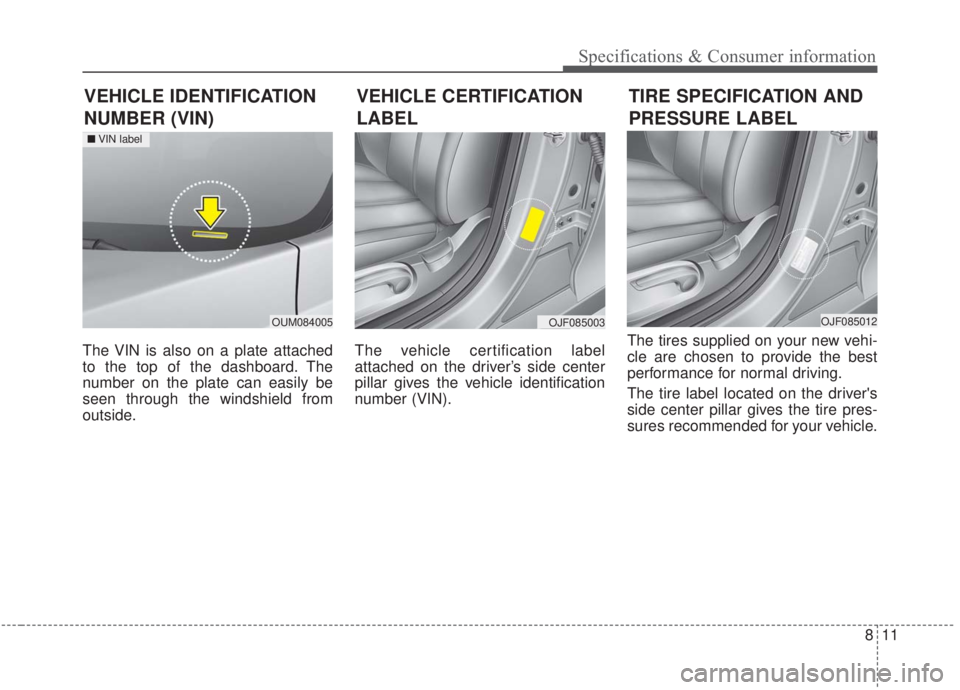
811
Specifications & Consumer information
The VIN is also on a plate attached
to the top of the dashboard. The
number on the plate can easily be
seen through the windshield from
outside.The vehicle certification label
attached on the driver’s side center
pillar gives the vehicle identification
number (VIN).
The tires supplied on your new vehi-
cle are chosen to provide the best
performance for normal driving.
The tire label located on the driver's
side center pillar gives the tire pres-
sures recommended for your vehicle.
VEHICLE CERTIFICATION
LABEL
OUM084005
■
VIN label
OJF085003
VEHICLE IDENTIFICATION
NUMBER (VIN) TIRE SPECIFICATION AND
PRESSURE LABEL
OJF085012
Page 557 of 568
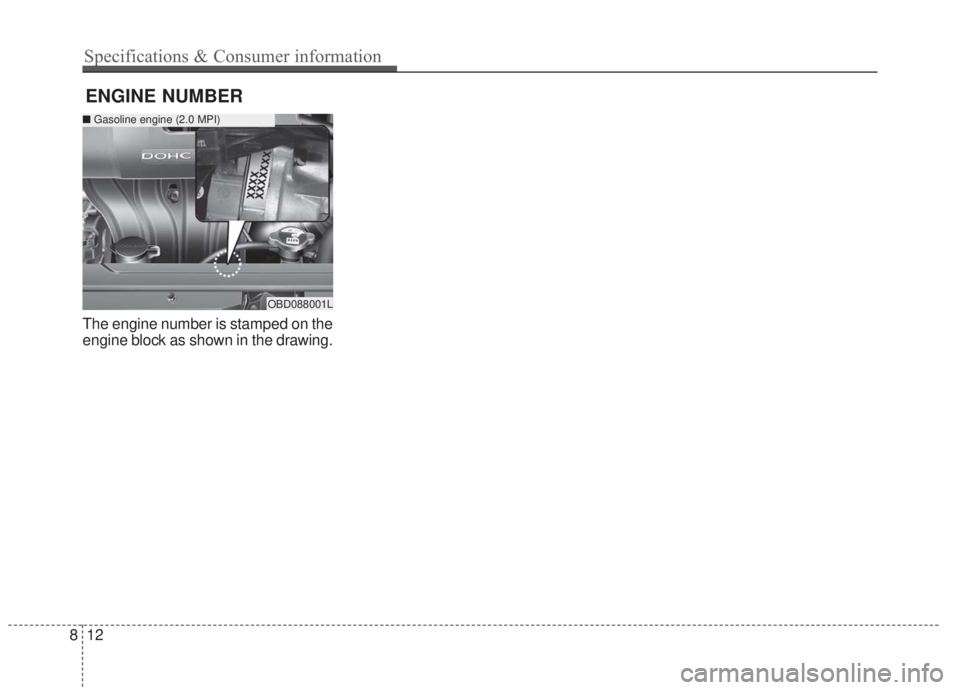
The engine number is stamped on the
engine block as shown in the drawing.
ENGINE NUMBER
OBD088001L
■Gasoline engine (2.0 MPI)
812
Specifications & Consumer information
Page 558 of 568
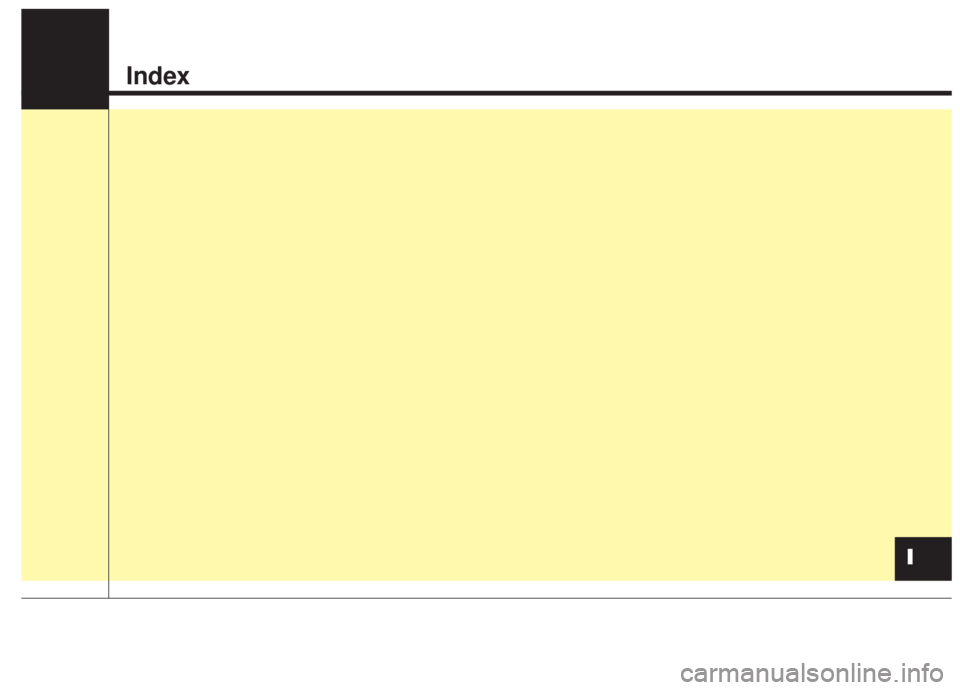
Index
I
Page 559 of 568
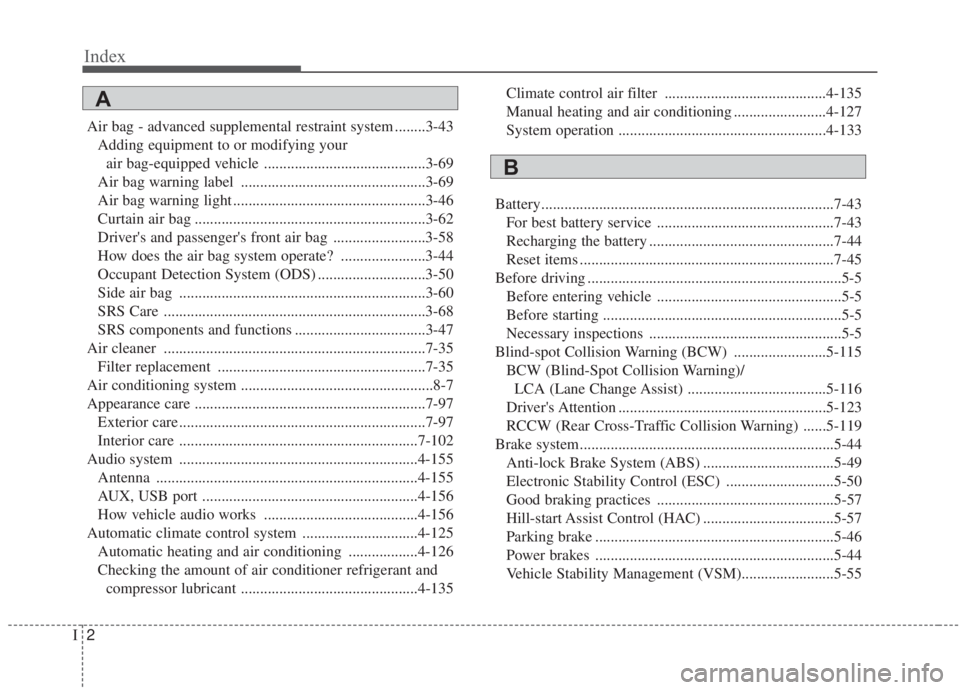
Index
2I
Air bag - advanced supplemental restraint system ........3-43Adding equipment to or modifying your air bag-equipped vehicle ..........................................3-69
Air bag warning label ................................................3-69
Air bag warning light ..................................................3-46
Curtain air bag ............................................................3-62
Driver's and passenger's front air bag ........................3-58
How does the air bag system operate? ......................3-44
Occupant Detection System (ODS) ............................3-50
Side air bag ................................................................3-60
SRS Care ....................................................................3-68\
SRS components and functions ..................................3-47
Air cleaner ....................................................................7-35\
Filter replacement ......................................................7-35
Air conditioning system ..................................................8-7
Appearance care ............................................................7-97 Exterior care ................................................................7-97
Interior care ..............................................................7-102
Audio system ..............................................................4-155 Antenna ....................................................................4-15\
5
AUX, USB port ........................................................4-156
How vehicle audio works ........................................4-156
Automatic climate control system ..............................4-125 Automatic heating and air conditioning ..................4-126
Checking the amount of air conditioner refrigerant and compressor lubricant ..............................................4-135 Climate control air filter ..........................................4-135
Manual heating and air conditioning ........................4-127
System operation ......................................................4-133
Battery........................................................................\
....7-43 For best battery service ..............................................7-43
Recharging the battery ................................................7-44
Reset items ..................................................................7-45
Before driving ..................................................................5-5 Before entering vehicle ................................................5-5
Before starting ..............................................................5-5
Necessary inspections ..................................................5-5
Blind-spot Collision Warning (BCW) ........................5-115 BCW (Blind-Spot Collision Warning)/LCA (Lane Change Assist) ....................................5-116
Driver's Attention ......................................................5-123
RCCW (Rear Cross-Traffic Collision Warning) ......5-119
Brake system..................................................................5-44 Anti-lock Brake System (ABS) ..................................5-49
Electronic Stability Control (ESC) ............................5-50
Good braking practices ..............................................5-57
Hill-start Assist Control (HAC) ..................................5-57
Parking brake ..............................................................5-46
Power brakes ..............................................................5-44
Vehicle Stability Management (VSM)........................5-55
A
B
Page 560 of 568
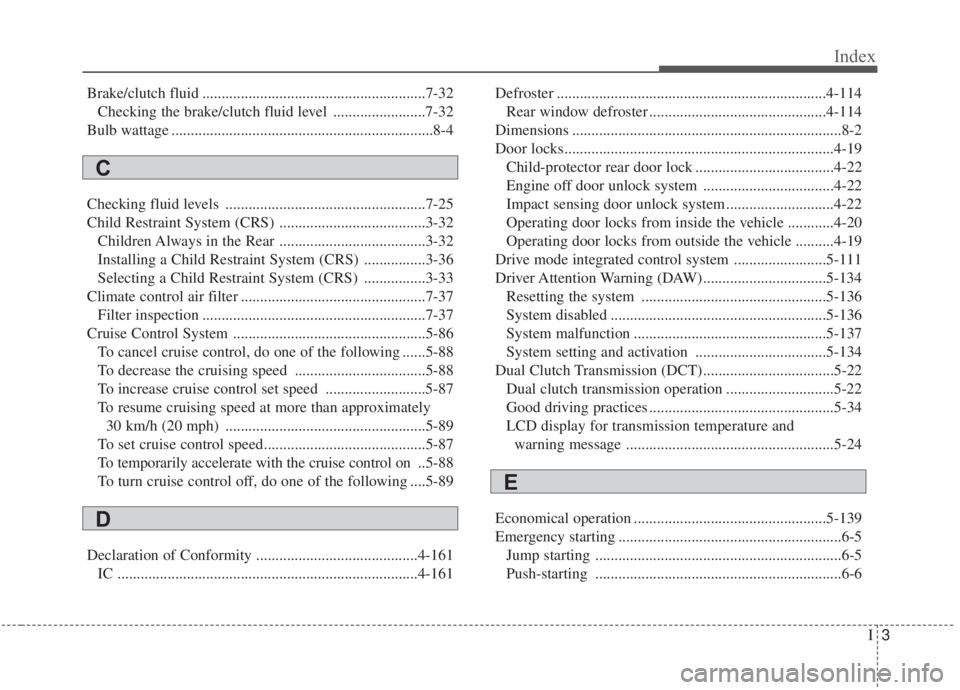
I3
Index
Brake/clutch fluid ..........................................................7-32Checking the brake/clutch fluid level ........................7-32
Bulb wattage ....................................................................8-4
Checking fluid levels ....................................................7-25
Child Restraint System (CRS) ......................................3-32 Children Always in the Rear ......................................3-32
Installing a Child Restraint System (CRS) ................3-36
Selecting a Child Restraint System (CRS) ................3-33
Climate control air filter ................................................7-37 Filter inspection ..........................................................7-37
Cruise Control System ..................................................5-86 To cancel cruise control, do one of the following ......5-88
To decrease the cruising speed ..................................5-88
To increase cruise control set speed ..........................5-87
To resume cruising speed at more than approximately 30 km/h (20 mph) ....................................................5-89
To set cruise control speed..........................................5-87
To temporarily accelerate with the cruise control on ..5-88
To turn cruise control off, do one of the following ....5-89
Declaration of Conformity ..........................................4-161 IC ........................................................................\
......4-161 Defroster ......................................................................4-\
114
Rear window defroster ..............................................4-114
Dimensions ......................................................................8-\
2
Door locks......................................................................4-\
19 Child-protector rear door lock ....................................4-22
Engine off door unlock system ..................................4-22
Impact sensing door unlock system ............................4-22
Operating door locks from inside the vehicle ............4-20
Operating door locks from outside the vehicle ..........4-19
Drive mode integrated control system ........................5-111
Driver Attention Warning (DAW)................................5-134 Resetting the system ................................................5-136
System disabled ........................................................5-136
System malfunction ..................................................5-137
System setting and activation ..................................5-134
Dual Clutch Transmission (DCT)..................................5-22 Dual clutch transmission operation ............................5-22
Good driving practices ................................................5-34
LCD display for transmission temperature and warning message ......................................................5-24
Economical operation ..................................................5-139
Emergency starting ..........................................................6-5 Jump starting ................................................................6-5
Push-starting ................................................................6-6
C
D
E